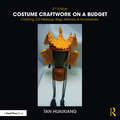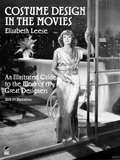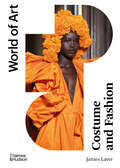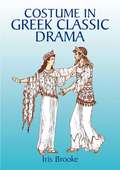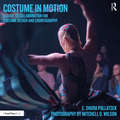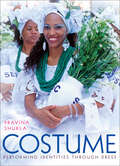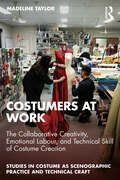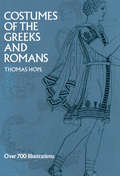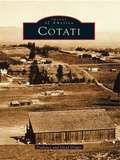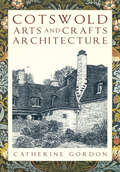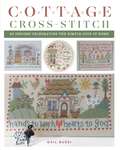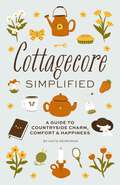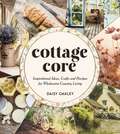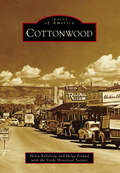- Table View
- List View
Costume And Fashion: A Concise History
by James Laver Amy de la HayeThe new fifth edition of this classic guide to clothing throughout history now extends into the second decade of the 21st century. James Laver's classic study of clothing, from the invention of the needle to the dawn of denim, neolithic weavers to catwalk creations, has been updated once again to cover the latest trends, from vintage to high street chic and the spectacular reinvention of haute couture. Featuring designers such as Alexander McQueen and Marc Jacobs, and style leaders Kate Moss and the Duchess of Cambridge, a new final chapter explains the forces shaping fashion today, including Internet technology, celebrity influence, 'fast fashion', the recession and global markets. With eight new pages, six new illustrations and an entirely new final chapter, this book reclaims its position as the definitive concise history of the subject, and remains essential reading for all students of art, costume and fashion.
Costume Construction (2nd Edition)
by Katherine Strand-EvansThis invaluable reference book leads the reader, step by step, through the stages of costume construction: from shop organization, pattern development, fabric selection and modification, to the more specific construction techniques for shoes, hats, masks, armor, and jewelry. It is intended for painters, pattern makers, drapers, artists, sculptors, milliners, seamsters, as well as those who enjoy handwork. Readers will learn not only the basic skills of sewing, drafting, draping, and millinary, but also all the techniques necessary for a successful career in the exciting world of costume crafts. Among its outstanding features, Costume Construction includes: (1) more than 300 illustrations, charts, and diagrams; (2) a comprehensive section on costume maintenance and storage; and (3) practical exercises at the end of each chapter.
Costume Craftwork on a Budget: Clothing, 3-D Makeup, Wigs, Millinery & Accessories
by Tan HuaixiangCostume Craftwork on a Budget demonstrates how to use inexpensive materials to create durable costumes and props in a short amount of time. Fully illustrated step-by-step instructions teach readers how to use 3-D makeup and create teeth, wigs, masks, hats, nonhuman costumes, leather products, and other accessories. This new edition features updated introductions for each chapter and project, expanded chapters on 3-D Makeup, Wigs, Masks, Headdresses, and Animal Costumes, and projects from shows such as Shrek the Musical (latex ears), Orphie & the Book of Heroes (headdresses), and Side Show (a lizard costume). From creating armor out of laundry baskets to detailed tricks for creating a witch’s prosthetic nose, this book equips aspiring costume designers with the techniques needed to produce costumes and props that are beautiful, economical, and safe.
Costume Design 101: The Business and Art of Creating Costumes for Film and Television
by Richard LaMotteWritten by an industry venteran with 40 years of experience, this book is the new edition of Costume Design
Costume Design in the Movies: An Illustrated Guide to the Work of 157 Great Designers
by Elizabeth LeeseFascinating, comprehensive reference work provides biographical/career data for major American, British, and French designers since 1909: Theoni V. Aldredge (The Great Gatsby), Edith Head, (The Greatest Show on Earth), Orry-Kelly (An American in Paris), Irene Sharaff (Funny Girl) and many others. Updated to 1988. 177 illustrations, invaluable index of 6,000 films.
Costume Design: The Basics (The Basics)
by T.M. DelligattiCostume Design: The Basics provides an overview of the fundamental principles of theatrical costume design, from pre-production through opening night. Beginning with a discussion of what is costume design, why do people wear clothes, and what is the role of the costume designer, this book makes accessible the art and practice of costume design. Peppered with interviews with working costume designers, it provides an understanding of what it means to be a costume designer and offers a strong foundation for additional study. Readers will learn: How to use clues from the script to decipher a character’s wardrobe Methods used to sketch ideas using traditional or digital media How to discuss a concept with a team of directors, producers, and designers Strategies to use when collaborating with a professional costume shop How to maintain a healthy work/life balance Courses of action when working under a limited money and labor budget. Costume Design: The Basics is an ideal starting point for aspiring designers looking for ways to achieve the best costumes on stage and realize their vision into a visual story told through clothing.
Costume Through the Ages: Over 1400 Illustrations
by Erhard KlepperFew books of costume design will prove more useful to artists, students, stage designers, and scholars than this volume. Presenting detailed drawings in a continuous chronological format, it provides a history of costume design through the ages, from the first century A.D. to 1930.Culled from sculpture, lithographs, paintings, illuminated manuscripts, engravings, caricatures, fashion plates, photographs, and magazines, these illustrations have been carefully redrawn to bring out essential lines as well as all the details. Men, women, and children are shown in authentic dress, in characteristic period postures, and coiffed in contemporary hairstyles -- even their gestures and bearing offer the reader insight into the attitudes and manners of their times. Due to the acceleration of change in styles, the book moves from single pages representing entire centuries to one-page-per-year depictions of fashion development. In all, more than 1,400 illustrations chronicle the full sweep of two millennia of Western garb, from Roman noble to Victorian dandy, from Elizabethan lady to Jazz Age schoolboy -- all in easily accessible form.Painstakingly researched and meticulously detailed, this book will be a valuable asset and resource for students, illustrators, costume and cultural historians -- anyone interested in the history of fashion.
Costume and Fashion: A Concise History (World of Art #0)
by James LaverAn authoritative account of the history of fashion and costume from prehistoric times to today. From the momentous invention of the needle some 40,000 years ago to the development of blue denim, from Neolithic weavers to the biggest names in the fashion industry today, this classic guide covers the landmarks of costume history. Costume and Fashion explores the forms and materials used in fashion through the ages, the underlying motives of fashion, and the ways in which clothes have been used to protect, express identity, and attract or influence others. This updated sixth edition features a new foreword and concluding chapter by Amy de la Haye and a new discussion about the major political shifts within the fashion industry, highlighting how it has responded to issues surrounding racism and sexism, LGBTQIA rights, mental health awareness, body and age diversity, and global sustainability. Generously illustrated with paintings, drawings, and photographs, and with a new angle on the emergence of ethical fashion, Costume and Fashion feels more current than ever.
Costume and History in Highland Ecuador
by Ann Pollard Rowe Lynn A. MeischThe traditional costumes worn by people in the Andes—women’s woolen skirts, men’s ponchos, woven belts, and white felt hats—instantly identify them as natives of the region and serve as revealing markers of ethnicity, social class, gender, age, and so on. Because costume expresses so much, scholars study it to learn how the indigenous people of the Andes have identified themselves over time, as well as how others have identified and influenced them. Costume and History in Highland Ecuador assembles for the first time for any Andean country the evidence for indigenous costume from the entire chronological range of prehistory and history. The contributors glean a remarkable amount of information from pre-Hispanic ceramics and textile tools, archaeological textiles from the Inca empire in Peru, written accounts from the colonial period, nineteenth-century European-style pictorial representations, and twentieth-century textiles in museum collections. Their findings reveal that several garments introduced by the Incas, including men’s tunics and women’s wrapped dresses, shawls, and belts, had a remarkable longevity. They also demonstrate that the hybrid poncho from Chile and the rebozo from Mexico diffused in South America during the colonial period, and that the development of the rebozo in particular was more interesting and complex than has previously been suggested. The adoption of Spanish garments such as the pollera (skirt) and man’s shirt were also less straightforward and of more recent vintage than might be expected.
Costume and Ornament of the Middle Ages in Full Color (Dover Pictorial Archive)
by Henry ShawMore than a pictorial archive of medieval dress and decoration, this beautiful collection is also valuable for its discerning scholarship. A magnificent compilation of artwork from Henry Shaw's detailed study of court life in the Middle Ages, this splendid book provides a grand display of medieval figures and fashions of the times.Reproduced directly from Shaw's original, hand-colored plates and identified by brief captions, more than 200 superb illustrations depict knights in battle, ladies in waiting, kings, queens, popes, and commoners, as well as armor and weapons, jewelry, and other decorative accessories. Skillfully adapted from rare paintings, illuminated manuscripts, tapestries, textiles, and stained glass windows, these lovely illustrations will be invaluable to fashion historians and costume designers. Craftworkers will find them equally useful.
Costume in Greek Classic Drama (Dover Pictorial Archive Ser.)
by Iris BrookeAt the peak of its perfection in the fifth century B.C., the glory of classical Greek drama was matched by the magnificence of its costumes. This work describes how performers were dressed in plays by Aeschylus, Sophocles, and Euripides, and explains how the actors' performances influenced the cut of their costumes. 53 black-and-white illustrations.
Costume in Motion: A Guide to Collaboration for Costume Design and Choreography
by Shura PollatsekCostume in Motion is a guide to all stages of the collaboration process between costume designers and choreographers, documenting a wide range of approaches to the creation of a dance piece. Featuring interviews with a diverse selection of over 40 choreographers and designers, in-depth case studies of works by leading dance companies, and stunning original photography, the book explores the particular challenges and creative opportunities of designing for the body in motion. Filled with examples of successful collaborations in contemporary and modern dance, as well as a wide range of other styles, Costume in Motion provides costume designers and choreographers with a greater understanding of the field from the other’s perspective. The book is designed to be part of the curriculum for an undergraduate or graduate level course in costume design or choreography, and it can also be an enriching read for artists at any stage of their careers wishing to hone their collaboration skills in dance.
Costume, Makeup, and Hair
by Robin Blaetz Tamar Jeffers Mcdonald Prudence Black Adrienne L. Mclean Drake Stutesman James Castonguay Karen De Perthuis Mary DesjardinsMovie buffs and film scholars alike often overlook the importance of makeup artists, hair stylists, and costumers. With precious few but notable exceptions, creative workers in these fields have received little public recognition, even when their artistry goes on to inspire worldwide fashion trends. From the acclaimed Behind the Silver Screen series, Costume, Makeup, and Hair charts the development of these three crafts in the American film industry from the 1890s to the present. Each chapter examines a different era in film history, revealing how the arts of cinematic costume, makeup, and hair, have continually adapted to new conditions, making the transitions from stage to screen, from monochrome to color, and from analog to digital. Together, the book's contributors give us a remarkable glimpse into how these crafts foster creative collaboration and improvisation, often fashioning striking looks and ingenious effects out of limited materials. Costume, Makeup, and Hair not only considers these crafts in relation to a wide range of film genres, from sci-fi spectacles to period dramas, but also examines the role they have played in the larger marketplace for fashion and beauty products. Drawing on rare archival materials and lavish color illustrations, this volume provides readers with both a groundbreaking history of film industry labor and an appreciation of cinematic costume, makeup, and hairstyling as distinct art forms.
Costume: Performing Identities Through Dress
by Pravina ShuklaWhat does it mean to people around the world to put on costumes to celebrate their heritage, reenact historic events, assume a role on stage, or participate in Halloween or Carnival? Self-consciously set apart from everyday dress, costume marks the divide between ordinary and extraordinary settings and enables the wearer to project a different self or special identity. Pravina Shukla offers richly detailed case studies from the United States, Brazil, and Sweden to show how individuals use costumes for social communication and to express facets of their personalities.
Costumers at Work: The Collaborative Creativity, Emotional Labour, and Technical Skill of Costume Creation (Studies in Costume as Scenographic Practice and Technical Craft)
by Madeline TaylorCostumers at Work: The Collaborative Creativity, Emotional Labour, and Technical Skill of Costume Creation explores the various forms of work carried out in the costume workshop by the myriads of skilled professionals who transform ideas and sketches into the wearable costumes seen on stage.Costume work, as collective, collaborative, and material labour produced by a predominantly female workforce, has been long overlooked by the performance industry and those who study it. This book exposes the inherent tensions between theatre’s strict hierarchies and collaborative ideology and how these inform the structures negotiated day to day by costumers as they carry out their work. Through close attention to their work, the book establishes costumers’ work as collaborative and complex, a creative and emotional labour that contributes to enhanced storytelling, actor performance, and audience experience. Using extensive ethnographic observation conducted over 14 months at three professional theatre costume workshops around Australia, combined with extant interviews and research from across the globe, Costumers at Work provides explicit theories and guidance about the behaviours, skills, and communication modes that make costume collaboration more effective and enjoyable.This book is written for costume researchers, practitioners, and students of theatrical costume design and construction, along with theatre scholars broadly.
Costumes of the Greeks and Romans (Dover Pictorial Archive Ser.)
by Thomas HopeFrom headdresses to sandals, from warrior's armor to priestess's robes, the authentic costumes of people from all walks of life in the Roman and Greek civilizations are here pictured comprehensively and clearly. Three hundred finely drawn, detailed engravings (containing over 700 illustrations) show just what was worn by the poets, philosophers, priests and priestesses, peasants, Bacchanalians, emperors, generals, Amazons, and virgins of a bygone age.Carefully copied from ancient vases and statuary by Thomas Hope (1770–1831), a British collector and designer, these engravings combine an unusual clarity of style with unquestioned authenticity. Their range, too, is unusually great, for besides the many plates on the costumes of the Greeks and Romans, there are representative illustrations of the typical dress of such other civilizations as the Phrygian, Egyptian, Parthian, Etruscan, and Persian.In addition, scores of engravings are devoted to such now-forgotten objects as ancient musical instruments (the lyre, double flute, pipes of Pan, etc.), Bacchanalian implements, articles of furniture, women's trinkets and jewelry, sarcophagi, altars, and other adjuncts to ancient life.Such comprehensiveness makes this book indispensable to costume designers, stage fitters, and producers of classic plays, students of fashion design, and others interested in ancient costumes. The material included here is covered in no ordinary history, and only here can the interested reader discover just how the draping of the Greek robe was achieved, or what was worn at festivals and funerals by the various classes.Art directors, advertising managers, and others on the lookout for unusual and eye-catching illustrations will also treasure this collection. All of the engravings are royalty free and may be used in any way, whether as striking contrasts to modern styles in dress, jewelry, or furniture; for historical perspective; for mood pieces; or simply as unusual attention-getters.
Cotati (Images of America)
by Lloyd Draper Prudence DraperThe town of Cotati, once the Coast Miwok village of Kot'ati, was by 1850 a 17,000-acre diamond-shaped ranch set in the center of Sonoma County's golden fields. Dr. Thomas Stokes Page and his heirs ran that ranch until the 1890s, when they laid out a town and a distinctive hexagonal plaza with streets named after Dr. Page's sons. That wheel-like plaza earned centrally located Cotati the title, "Hub of Sonoma County." For many years Cotati was the gathering place for hundreds of hardworking chicken ranchers, who bought up small farms in the surrounding countryside, but it was transformed in the 1970s into a hippie haven fed by nearby Sonoma State University. Old chicken houses then became student housing and the Plaza hub that was the setting for traditional community festivals became a vibrating stage for dancing and demonstrations. Cotati's famous downtown nightclub, the Inn of the Beginning, was the proving ground for many now-famous musicians, including John Lee Hooker, Huey Lewis, Vince Guaraldi, Roseanne Cash, and Kate Wolf.
Cotswold Arts and Crafts Architecture
by Catherine GordonBetween 1890 and 1930, Arts and Crafts architecture proliferated within the Cotswolds. The range and quality of the buildings was exceptional, as the region provided the perfect environment for the Movement’s ideals and principles to flourish. Arts and Crafts architects relished the robust vernacular precedent that served to focus their ideas and stimulate their creativity. Its rational basis and dependence on craft skills had lasting relevance, and it was no coincidence that the most infl uential aspect of their work was its emphasis on conservation. The achievements of the Arts and Crafts Movement in the Cotswold region has attracted much interest in recent decades, the appeal of the simple life and traditional values having as much allure now as they did a century ago. This was the first study to focus entirely on the Arts and Crafts architecture within the region, and to examine its impact on the Cotswold landscape, on the survival of the local building traditions and attitudes to heritage and conservation. This new and updated paperback edition provides a guide to the general characteristics of Cotswold Arts and Crafts structures, with chapters on the various types of new commissions to be found, as well as repair and remodeling projects. The final chapter discusses the late flowering of Arts and Crafts work that occurred during the interwar period and beyond, and the legacy of this important body of work at a local and national level.
Cottage Cross-Stitch: 20 Designs Celebrating the Simple Joys of Home
by Gail BussiCross-stitch your cottage life!Whether you live in a cottage or an urban apartment, if you daydream of a simple life in a little house on a hill or near the sea, this book is full of designs that will inspire and feed your love of all things homey and sweet. The 20 stitchings feature a variety of tiny homes--from cabins with beautiful gardens to hobby farms and even a little camper home--and the relaxing rituals of cottage living, such as baking, gardening, and enjoying wildlife and sunshine. Every project includes chart, finished photo, materials, and full instructions. Find your peace as you make each stitch, and then display your work where you can be transported to your cottage dream every time you see it!
Cottage Grove
by Angela Garvin Caleb GarvinCottage Grove is a picturesque little hometown nestled in the Willamette Valley. Pioneers following the Oregon Trail west settled in the area in the early 1800s. The Bohemia Mountains were the first major draw to the area after James "Bohemia" Johnson discovered gold in 1863. A gold rush ensued and caused several boom towns to spring up on the route to the mines. After several years, many millions in gold were blasted from the mountains. There is an estimated $14 million in gold remaining in the mountain to this day. With new settlers came the first post offices and schools. When the mining started to slow down, the lumber industry was on the upswing. With easy access to the short line and virgin timber on every hill in the valley, timber became the new boom. Mills sprung up almost overnight, and in some cases burned in a single night. At one time, there were 23 mills on Row River alone.
Cottagecore Simplified: A Guide to Countryside Charm, Comfort and Happiness (Simplified Series)
by Katie MerrimanImagine this: you have a hot cup of tea and a good book in front of you, the aroma of freshly baked bread in the air as sunlight streams in through the window. Daydreaming of a simpler life? Go back to the basics with Cottagecore Simplified.It might not be practical to drop everything and live out your fairytale fantasy, but it&’s easy to embrace countryside comfort while coexisting with the modern world—find inspiration in the crafts, décor, and lifestyle tips in this book. This guide is designed to bring peace and relaxation to your life.Inside you&’ll find:Recipes for baked breads, pies, pastries, and moreEmbroidery, sewing, and quilt patternsIdeas for sketches and doodlesAn introduction to candle and soap makingTips for maintaining your gardenPottery, flowerpressing, and other charming craftsAnd more!Life is all about enjoying the simple things. This idyllic aesthetic allows you to break from monotony and routine. Start off friends and family in their new home with this ideal housewarming gift, or take the plunge yourself into DIY projects and low-waste living. Unplug from the modern world and bring cottagecore to your everyday life with Cottagecore Simplified.
Cottagecore: Inspirational Ideas, Crafts and Recipes for Wholesome Country Living
by Daisy OakleyWelcome to Cottagecore – a world full of wildflower meadows and picnics, homemade jam and floaty dresses, traditional crafts and cosy country retreats. Rekindle your love for nature and find solace in the soothing art of cottagecore with the help of this beautiful book of recipes, crafts, activities and design ideas.
Cotting School (Campus History)
by Elizabeth Campbell Peters David ManzoIn 1893, two pioneering orthopedic surgeons, Dr. Augustus Thorndike and Dr. Edward Bradford, saw the need to educate children whose physical challenges prevented them from attending school. As an experiment, they founded the Industrial School for Crippled and Deformed Children in Boston. Modeled after 19th-century European institutions, the school was America's first for children with physical disabilities. Early classes were held in a church basement where Mary Perry volunteered to teach seven students. Tuition, a hot meal, and transportation in a horse-drawn carriage were free. Thanks to the leadership of the two doctors and board chairman Francis Joy Cotting, within 10 years the school was housed in an impressive, debt-free brick building. Renamed the Cotting School, the school is now located in Lexington and serves 130 day students from 74 communities. Staffed with highly skilled special education teachers; nurses; physical, occupational, and communication therapists; and dental and vision specialists, Cotting is a national leader in serving children with a broad spectrum of learning and communication disabilities, physical challenges, and complex medical conditions.
Cottonwood
by Helga Freund Verde Historical Society Helen KillebrewIn the last quarter of the 19th century, a circle of 16 tall Cottonwood trees stood in the wash that extended to the Verde River just north of where the old jail building now stands. Cattlemen and ranchers from Oak Creek and the mountains made their overnight stops under these trees and the location became known as "The Cottonwoods." The lush riparian area attracted hardy settlers, and Fort Verde's military camp and the copper mines of Jerome provided a ready market for agricultural goods. Thus began the town that was soon to become the commercial hub for the Verde Valley. Today the incorporated city of Cottonwood serves an area population of over 55,000 and boasts a diverse economy based on health care, education, tourism, and the service and retail industries. With its moderate climate, beautiful setting, and small-town charm, combined with the amenities of a larger city, Cottonwood continues to attract steady growth and tourism.
Cotuit and Santuit
by James W. Gould Jessica Rapp GrassettiCotuit, a name derived from a Native American word meaning "place of the council," has a rich history that predates Colonial times and includes continuous Native American habitation. Paired with Santuit on the south shore of Cape Cod and warmed by the Gulf Stream, Cotuit has long been a favorite summer resort and was home to Cape Cod's first hotel. Its greatest attraction has always been the sweet Cotuit oysters, which are shipped to the best shellfish bars in the country.This quiet and unspoiled New England village, once a refuge for pirates, deepwater sailors, and coastal traders, hold secrets that are told only in Cotuit and Santuit. They are home to such people as Henry Adams, whose courtship took place here; the Cape Cod Commandos; a pioneer whistle-blower fighting against environmental pollution; and the witch Hannah Screecham, who guarded Captain Kidd's treasure. Cotuit and Santuit reveals the adventures of the Holy Ghost Festival, the baby brought home from the Pacific whaling grounds in a cask of rum, and the trek over the Arctic Ocean across thirty miles of ice.


